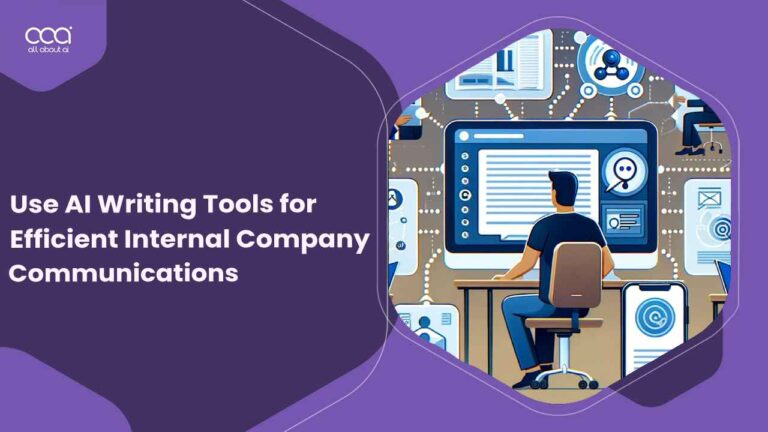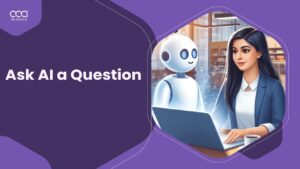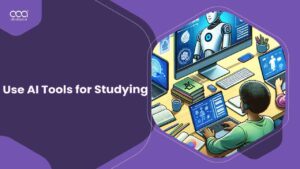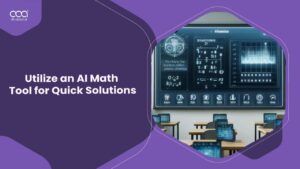The integration of Artificial Intelligence (AI) in internal company communications is transforming the landscape of workplace interactions. Learning how to use AI writing tools for efficient internal company communications is becoming increasingly crucial as businesses strive to enhance the effectiveness and efficiency of their messaging.
This strategic shift, powered by AI, is pivotal for organizations looking to streamline their communication processes and foster a more connected and informed workforce. As we dive deeper into the digital age, the role of best AI writing tools in redefining internal communications is becoming more pronounced, offering innovative solutions that align with the dynamic needs of modern businesses.
How to Use AI Writing Tools for Efficient Internal Company Communications – Step-By-Step Guide
Learn to harness AI for crafting efficient internal communications with our step-by-step guide, designed to boost clarity, engagement, and productivity in your organization’s messaging strategies.
Step 1: Identify the Communication Objective
Clearly define the purpose of your internal communication. Whether it’s to inform, request input, or announce changes, understanding the objective will guide the AI in generating relevant content.
Practical Example:
I needed to inform my team about an upcoming cybersecurity training. I specified to Chatgpt, “Draft an informative email about the scheduled cybersecurity training session for the team.” The AI provided a concise draft that clearly communicated the training’s details, purpose, and expectations.
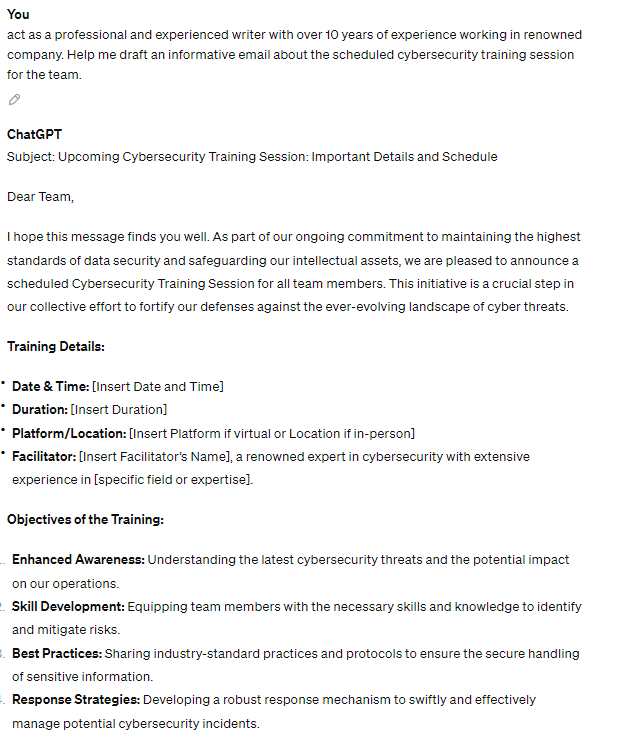
Step 2: Determine the Target Audience
Identify who the message is for within the company. Tailoring the tone, complexity, and content based on the audience (e.g., executives, a specific department, or all employees) ensures the communication is effective and well-received.
Practical Example:
My audience was the entire tech department. I asked ChatGPT, “Adjust the draft to suit a tech-savvy audience, including specific technical requirements for the training.” The AI fine-tuned the message, making it more relevant and engaging for the department members.
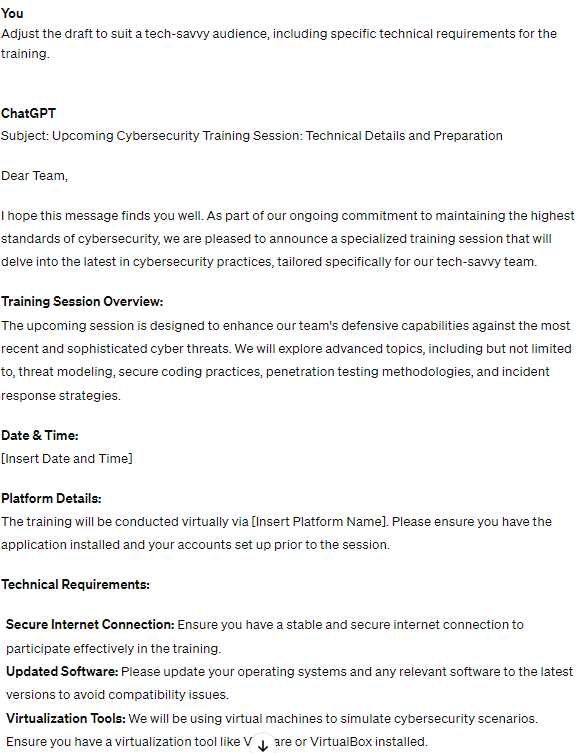
Step 3: Draft the Initial Message
Use AI to create a first draft of your communication. Provide the AI with the necessary information and context to generate a clear and coherent message.
Practical Example:
I needed a follow-up message to encourage participation. I instructed ChatGPT, “Create a follow-up message to encourage participation in the cybersecurity training, highlighting its benefits.” The AI crafted an engaging follow-up that emphasized the training’s value and the positive impact on the team’s skills.
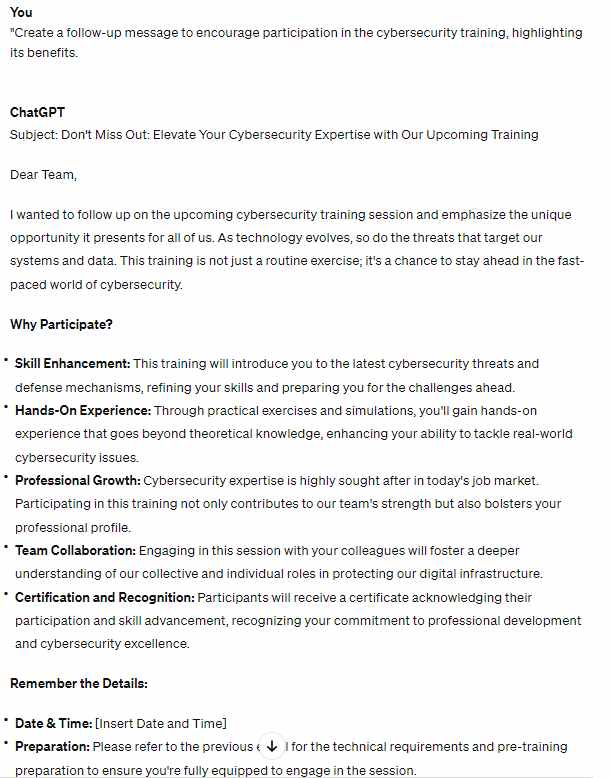
Step 4: Personalize and Humanize the Content
While AI can draft effective messages, adding a personal touch can enhance readability and connection with the audience. Personalization makes the communication feel more genuine and less automated.
Practical Example:
To add a personal touch, I told ChatGPT, “Incorporate a personal note from me in the message, expressing my enthusiasm for the team’s commitment to security.” ChatGPT added a personalized closing remark that reflected my voice and leadership style.
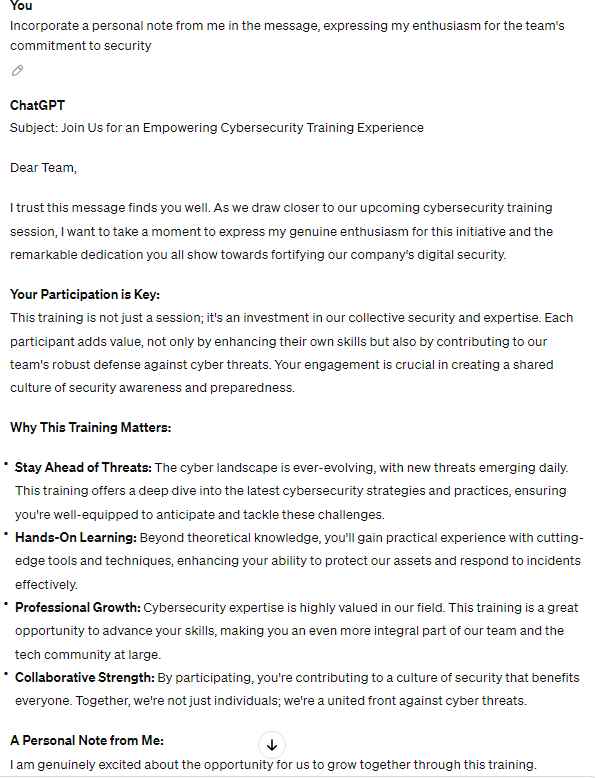
Step 5: Review and Refine the Message
Evaluate the AI-generated draft to ensure it meets your communication goals, is clear, and aligns with the company’s tone and policies. Make necessary revisions to improve clarity and impact.
Practical Example:
Before sending the message, I reviewed the draft and felt it needed a clearer call to action. I asked ChatGPT, “Revise the message to include a more direct call to action for confirming attendance.” The AI then enhanced the message with a clear and concise call to action.
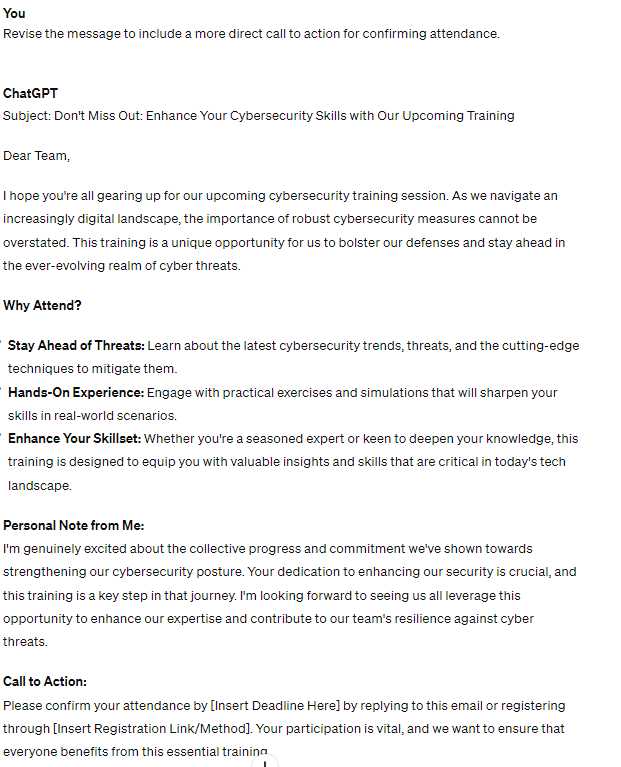
Step 6: Measure Feedback and Engagement
After distributing the communication, gather feedback to assess its effectiveness and engagement. This information can be used to improve future AI-assisted communications.
Practical Example:
After the training, I wanted to gauge its reception. I queried ChatGPT, “Draft a survey to collect feedback on the training session’s communication effectiveness.” The AI generated a concise survey, which helped gather valuable insights for future communications.
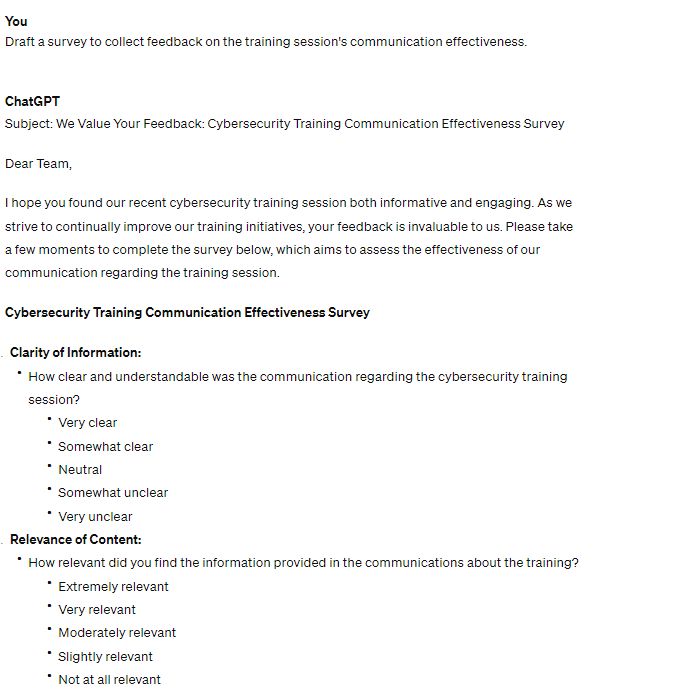
Understanding the Role of AI in Internal Communications
AI tools are transforming internal communications, making interactions more efficient and data-driven, which is crucial for the fast-paced business environments of today.
Real-time Enhancements:
AI significantly improves real-time communication capabilities, offering instant translations, summarizations, and even sentiment analysis, which can foster better understanding and collaboration among diverse teams.
Personalization at Scale:
By analyzing communication patterns and preferences, AI can tailor messages and updates to individual preferences, enhancing the relevance and effectiveness of internal communications.
Analytical Insights:
AI tools can sift through vast amounts of communication data to identify trends, bottlenecks, and opportunities for improvement, providing leaders with actionable insights to enhance communication strategies.
Volume Management:
In large organizations, AI can help manage the sheer volume of communications, ensuring that critical information is prioritized and disseminated effectively.
Engagement and Collaboration:
AI contributes to a more dynamic and engaging communication environment, fostering a sense of collaboration and community within the organization.
How to Use AI Writing Tools for Efficient Internal Company Communications – Best Practices
To harness the full potential of AI in internal communications, it’s crucial to follow best practices, especially when creating AI prompts.
Clear Objectives:
Define specific, measurable objectives for AI integration to ensure that the technology aligns with the organization’s communication goals and delivers tangible benefits.
Context-rich Prompts:
Develop detailed, context-rich prompts that guide AI in generating relevant and accurate responses, enhancing the effectiveness of AI-assisted communications.
Feedback and Refinement:
Regularly collect feedback on AI-generated communications and use this input to refine prompts and adjust AI settings, ensuring continuous improvement in communication quality.
Company-specific Training:
Train AI tools on the organization’s specific lexicon and communication norms to ensure that AI-generated messages are aligned with the company’s culture and values.
Scenario Testing:
Conduct thorough testing of AI-generated communications in various scenarios to assess accuracy, relevance, and effectiveness, ensuring that the AI tool is well-calibrated to the organization’s needs.
Understanding the Audience and Message Purpose
Tailoring AI-assisted communications to the audience and the message’s purpose is vital for ensuring that the information is engaging, relevant, and effective.
Audience Segmentation:
Use AI to segment the audience based on roles, departments, or preferences, allowing for more targeted and relevant communications.
Historical Analysis:
Analyze past communications to understand audience preferences and response patterns, which can help tailor AI-generated messages to better meet audience expectations.
Tone and Style Adaptation:
Employ AI to adapt the tone and style of communications to suit different internal groups, enhancing the clarity and receptivity of messages.
Key Message Identification:
Leverage AI to identify and emphasize key message points, ensuring that essential information is communicated clearly and effectively.
Impact Monitoring:
Utilize AI tools to monitor the impact of communications, gathering data on engagement and feedback, which can inform future communication strategies.
How to Use AI Writing Tools for Efficient Internal Company Communications – Uses in Internal Communication
Various AI writing tools offer unique benefits that can enhance the quality and effectiveness of internal communications.
Quillbot for Refinement:
This tool can help refine and paraphrase internal communications, ensuring messages are concise and clear, which is especially useful for complex or technical information.

Grammarly for Consistency:
Grammarly can check for grammatical accuracy and consistency in tone, which is crucial for maintaining professionalism and clarity in company-wide communications.
Jasper for Creativity:
Jasper can be used to generate creative content for internal reports and presentations, adding a dynamic and engaging element to routine communications.
OpenAI’s GPT-4 for Summarization:
AI tools like ChatGPT-4 can summarize content and condense important information, making it easier for employees to quickly grasp key points, which is particularly beneficial for lengthy documents or reports.
MonkeyLearn for Sentiment Analysis:
Tools like MonkeyLearn can help understand the emotional tone of communications, providing insights into how messages are perceived and enabling adjustments to enhance receptivity and engagement.
Enhancing Internal Communication Channels with AI
AI can improve various internal communication channels, making them more efficient and effective in fostering collaboration and information sharing.
Email Automation:
AI can auto-generate email responses and summarize lengthy email threads, saving time and ensuring that important information is highlighted and easily accessible.
Intranet Customization:
AI can personalize content on the company intranet, tailoring information and updates to individual preferences and roles, which can enhance engagement and information relevance.
Instant Messaging Bots:
AI bots in instant messaging platforms can provide quick access to information, answer queries, and facilitate routine tasks, enhancing efficiency and responsiveness.
Video Conferencing Tools:
AI-enhanced video conferencing can offer features like real-time transcription and translation, making meetings more accessible and productive, especially for diverse, global teams.

Project Management Automation:
AI can offer predictive insights in project management tools, automate status updates, and facilitate resource allocation, enhancing project efficiency and team collaboration.
How to Use AI Writing Tools for Efficient Internal Company Communications – The Benefits
Integrating AI tools into internal communications systems offers a range of benefits that can significantly enhance organizational efficiency and employee engagement.
Efficiency Gains:
By automating routine communication tasks, AI frees up employees to focus on more strategic and creative endeavors, enhancing overall productivity.
Personalized Communications:
AI enables the personalization of messages, ensuring that communications are relevant and engaging for each recipient, which can improve information retention and response rates.
Insightful Analytics:
AI-driven analytics provide valuable insights into communication patterns, employee engagement, and the effectiveness of different communication strategies, enabling data-driven decision-making.
Global Collaboration:
Real-time AI tools facilitate seamless collaboration across different time zones and languages, breaking down barriers and fostering a more inclusive and connected global workforce.
Identifying Communication Gaps:
AI can help identify gaps in internal communications, providing insights that can be used to improve information flow and ensure that all employees are informed and engaged.
AI’s Role in Time-Saving and Engagement Improvement
The impact of AI on saving time and improving engagement in internal communications is significant, offering both operational efficiencies and enhanced employee experiences.
Time-Saving:
AI reduces the time needed to create, manage, and respond to internal communications, allowing employees to allocate more time to value-adding activities.
Focus on Strategic Tasks:
With AI handling routine communications, employees can focus on strategic tasks, innovation, and creative problem-solving, which can drive organizational growth and success.

Enhanced Engagement:
Personalized AI-driven communications are more likely to engage employees, ensuring that messages are relevant and resonant, which can improve morale and productivity.
Feedback Loops:
Automated feedback loops facilitated by AI can help organizations quickly gather and act on employee feedback, enabling continuous improvement in communication strategies.
Responsive Communication Environment:
AI contributes to a more responsive and dynamic internal communication environment, where information is shared efficiently, and employees feel more connected and informed.
The Challenges of AI in Internal Communications
While AI offers numerous benefits, its integration into internal communications also presents challenges that organizations need to navigate carefully.
Contextual Understanding:
Ensuring that AI tools fully understand company-specific jargon and context is crucial for effective communication, requiring ongoing training and refinement of AI models.
Human Touch:
Balancing automation with the human touch is essential, as employees value personal interactions, and certain situations require a human-centric approach to communication.
Employee Concerns:
Addressing concerns about AI and automation, particularly around job displacement or surveillance, is vital for gaining employee trust and buy-in.
Consistency and Branding:
Maintaining brand consistency in AI-generated communications can be challenging, requiring careful oversight and alignment with the organization’s values and messaging standards.
Learning Curve:
The adoption of new AI tools may involve a learning curve for employees, necessitating training and support to ensure effective utilization and integration into daily workflows.
Mitigating Privacy Concerns and Potential Risks
Addressing the potential risks associated with AI, particularly regarding privacy and data security, is crucial for ethical and effective implementation.
Data Privacy:
Implementing robust data privacy measures is essential to protect sensitive information and maintain trust, particularly when AI tools process personal or confidential communication data.
Transparency:
Maintaining transparency with employees about how AI is used in communications and how data is handled can alleviate concerns and foster a culture of trust and openness.
Bias and Accuracy:
Monitoring AI-generated communications for unintended biases or inaccuracies is essential to prevent miscommunications and ensure that messages are fair and balanced.
Guidelines and Compliance:
Establishing clear guidelines for AI use in internal communications can help ensure that the technology is used responsibly and in alignment with organizational values and legal requirements.
Regular Review:
Conducting regular reviews of AI tool performance and compliance can help identify and address any issues promptly, ensuring that the technology continues to meet the organization’s needs and standards.
Ethical Considerations in Using AI for Internal Communication
Balancing AI assistance with human expertise and ethical considerations is vital to ensure that AI-enhanced communications are effective, respectful, and aligned with organizational values.

Adherence to Ethical Standards:
Ensuring that AI tools adhere to high ethical standards, particularly concerning privacy, transparency, and fairness, is essential for responsible use.
Transparency with Employees:
Being transparent with employees about the use of AI in communications and the handling of data fosters trust and encourages responsible engagement with the technology.
Human Oversight:
Incorporating human oversight into the AI communication process ensures that messages are appropriate, accurate, and aligned with the organization’s culture and values.
Cultural Values:
Fostering an organizational culture that values ethical use of AI can encourage responsible practices and ensure that technology enhances rather than detracts from the workplace.
Continuous Assessment:
Regularly assessing AI tools for ethical implications, accuracy, and fairness can help organizations maintain high standards and address any issues proactively.
Preparing for the Future of AI in Internal Communications
As AI technology continues to evolve, organizations need to stay ahead of the curve, embracing innovations and adapting their communication strategies to leverage the latest advancements.
Staying Informed:
Keeping abreast of emerging AI technologies and their potential applications can help organizations identify new opportunities to enhance their internal communications.
Learning Culture:
Fostering a culture of continuous learning and adaptation encourages employees to embrace AI advancements and integrate new tools into their communication practices.
Collaborative Integration:
Encouraging cross-departmental collaboration in the adoption and integration of AI can ensure that the technology is used effectively and aligns with broader organizational goals.
Training and Development:
Investing in employee training on AI tools can maximize the benefits of the technology, ensuring that staff are equipped to use AI effectively in their communication tasks.
Forward-looking Strategies:
Developing strategies that anticipate future AI trends can position organizations to quickly adapt to new technologies, maintaining a competitive edge in communication efficiency and effectiveness.
Adapting to AI Advancements for Efficient Communication Strategies
Proactively adapting to the rapid advancements in AI can help organizations maintain efficient and effective communication strategies, staying ahead in a fast-evolving digital landscape.

Anticipating Technological Changes:
Being proactive in anticipating and preparing for new AI features and capabilities can enable organizations to integrate emerging technologies seamlessly and maintain a leading edge in communication practices.
Feedback and Adaptation:
Establishing feedback loops to gather input on AI tools and adapting strategies based on this feedback can ensure that AI continues to meet the organization’s communication needs effectively.
Industry Benchmarking:
Monitoring industry trends and benchmarking against peers can provide insights into best practices and innovative uses of AI in internal communications, offering opportunities for continuous improvement.
Scalable Solutions:
Investing in scalable AI solutions ensures that as the organization grows and evolves, the AI tools can adapt and expand to meet changing communication needs.
Innovation Culture:
Cultivating a culture that embraces innovation and views AI as a tool for enhancement rather than replacement can encourage ongoing experimentation and adoption of new technologies, driving continuous improvement in internal communications.
FAQs
Here are some of the most commonly asked questions about how to use AI writing tools for efficient internal company communications.
How do you write effective internal communication?
How generative AI can be used to improve employee communications?
How does AI affect internal communication within an organization?
Will AI replace internal communications?
Conclusion
The integration of AI into internal communications presents a transformative opportunity for organizations, enabling them to enhance efficiency, personalization, and data-driven decision-making. While AI offers significant benefits, such as automating routine tasks and providing valuable insights, it does not replace the need for human insight and the nuances of personal interaction.
In this guide, we have thoroughly discussed how to use AI writing tools for efficient internal company communications and everything related to it in detail. To learn more about usage of AI tools in different domains, check out more articles in our how-to guides or you can enhance your understanding of AI terms and concepts, by visiting our AI glossary.

